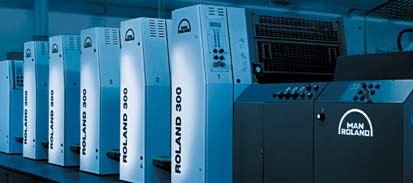Electrical Requirements
 Komori Presses no matter the size, original origin, or vintage, require 220Y Volts, three phase power. The amperage requirement is related to the size of the machine. You should also have an electrician confirm the availability of amperage in your building. Often when dealing with 40” machines the power needed can tax what is available. The effort to bring more amps into your building can often be expensive and take a long time. Therefore, be sure on the amount of amps a press you are interested requires. Don’t rely on people who think they know, find out for sure and include all auxiliary equipment. Many dryers can require as many amps as a press. Komori Presses no matter the size, original origin, or vintage, require 220Y Volts, three phase power. The amperage requirement is related to the size of the machine. You should also have an electrician confirm the availability of amperage in your building. Often when dealing with 40” machines the power needed can tax what is available. The effort to bring more amps into your building can often be expensive and take a long time. Therefore, be sure on the amount of amps a press you are interested requires. Don’t rely on people who think they know, find out for sure and include all auxiliary equipment. Many dryers can require as many amps as a press.
Even if the current that is available in your building is 220 V, the machine will need an electrical transformer. The machine will run without the transformer but you do not want to do this for anything other than jogging the machine around for installation or test purposes. This transformer must be an isolated transformer, dedicated to the press only. The transformer will need to be 220V, secondary. The secondary indication is what comes out of the transformer. The primary is what will go into the transformer, or what the power is in your building. Even if you think you know what the voltage is in your building you should have it checked by an electrician. The transformer should have taps, which will allow some adjustment of the voltages. For instance you may think you have 220V, but it could actually be 205V. Thus the voltage would need to be “tapped” up. In addition the electrician could check for fluctuations in the power. Often time’s large air conditioners can cause issues when they kick on and off.
Generally speaking the voltages in the US are, 208V, 220V, 240V, 480V.
The typical time you will need power during an installation is the second day. You will need to have an electrician on hand to bring the power from your power source to the transformer, and then to the press. Generally speaking all of this responsibility falls upon the printer. In fairness to those selling these machines the power situation in the printers building is unique to them. How far the wires will need to be laid, what the voltage is and the available amps are all a function of the cost of that printers building. If every installation were done in a brand new industrial building this cost could be more easily predicted.
Please consult the drawing of the “ideal” electrical installation. This example shows an incoming voltage of 440, however this electrical installation suggestion is the same no matter what the incoming voltage.
There is also a drawing that shows where the electrical hook-up is for the press. It is at the feeder end, gear side.
The electrical situation is something that becomes even more important if you are purchasing a machine that is coming from Europe. Every Komori made wants 220 volts; however all of the accessories are going to require different voltages. For instance a dryer that was installed for a machine in Europe is most likely going to require 380 Volts. You will have to have a transformer change what is in your building into what that dryer needs. For example a common European dryer is the IVT IR dryer. This is an excellent short wave dryer. However, it will need 380 volts, at 80 amps. Now if the power in your building is 220, you will now need a transform that is;
220 Y primary
380 Seconday
45 KVA
This is not something that you will be able to pick up on a moments notice and it will cost approximately $1,500.00. The dryer will not run with out it.
One thing to note about the IVT dryer is that it is water cooled. Be very careful if the press is going to be shipped in cold weather. If the system is not completely drained, and filled with antifreeze, it will freeze and crack the cooling unit.
It is also important to know that machines imported from outside of the US, will not carry UL approval. Most often this is not a problem, but if you’re electrical inspector or some other entity that you needed to pull a permit from comes around they can halt the operation of the machine. Getting UL approval is not an easy matter. In fact even finding out exactly what you would need to do is elusive.
- Every machine, no matter the voltages involved will need a transformer
- If the machine is from a foreign country the accessories will require foreign voltage, i.e. a transformer
- Transformers that need to convert US voltages into foreign voltages should be ordered well in advance
- The machine will need power around the second day of the installation
- The best thing to do is bring the power via conduit to where the machine will roughly be prior to the installation, then have the electrician finish when the machine has been bolted together.
- Foreign machines will not be UL approved

How can I find out more information?
We would be happy to provide you with a prompt and professional quotation on a printing press thats right for you. When you request a printing press quote you will receive a courteous and professional response with options you can choose. Take me There
| Home | Learning Center | Links | About Us | Contact Us | Join Our Network
|
